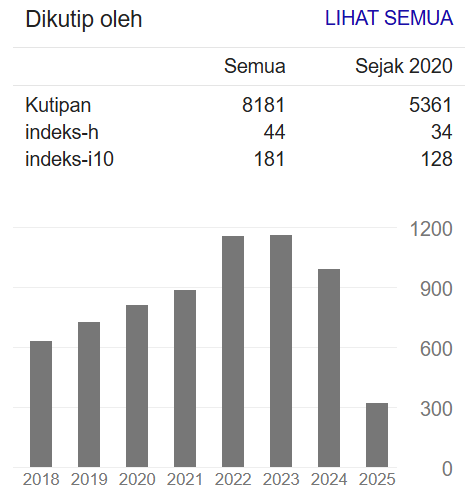EDUKASI CARA MENYIKAT GIGI BAGI SISWA SEKOLAH DASAR DENGAN MENGGUNAKAN APLIKASI TOUCH YOPICK
DOI:
https://doi.org/10.34011/jmp2k.v33i2.1795Keywords:
Dental Health, Knowledge Level, Touch YoPick AppAbstract
Information and Communication Technology is an important element in national and state life. Information technology has become the main facility for activities in various sectors of life, which has contributed greatly to fundamental changes in the operational structure and management of education, health and research. An application is a program that is ready to be used which is created to carry out a function for the user in solving problems using of this research is to dig up information on using the Touch YoPick Application, to find out how to brush your teeth using the Touch YoPick Application, to find out how to use the Touch YoPick Application properly. The design used in this research is a sequential exploratory mixed methods design. The first stage with qualitative research was to explore user needs for the YoPick Touch Application. The second stage is the application development stage so that a viable application is produced that meets user needs. Sampling used purposive sampling. The sample size was determined using the Slovin formula as 52 people. The results of the Touch YoPick Application make it easier for elementary school students to receive education about how to brush their teeth. It is hoped that the Touch YoPick application can also be used by other elementary schools. Measuring the level of technology readiness can be done using applications that function to develop the role of technology in the current digital era so that students can easily receive information.
References
I. Rusydi, “Peranan Perkembangan Teknologi,” J. Chem. Inf. Model., vol. 53, no. 9, pp. 1689–1699, 2019, [Online]. Available: https://www.neliti.com/id/publications/290643/peranan-perkembangan-teknologi-informasi-dan-komunikasi-dalam-kegiatan-pembelaja
R. Sarinastiti, A. N. Fajriyanto, D. R. Prabumukti, M. K. Insani, and K. Kunci, “Analisis Pengetahuan Perilaku Hidup Sehat dan Pemanfaatan Puskesmas (Analysis of Healthy Life Behavior Knowledge and Utilization of Public Health Centers),” Promot. J. Kesehat. Masy., vol. 8, pp. 61–71, 2018.
J. Andi, “Pembangunan Aplikasi Child Tracker Berbasis Assisted – Global Positioning System ( A-GPS ) Dengan Platform Android,” J. Ilm. Komput. dan Inform., vol. 1, no. 1, pp. 1–8, 2015.
Kemenkes RI, Injeksi 2018. 2020. [Online]. Available: https://www.kemkes.go.id/downloads/resources/download/pusdatin/profil-kesehatan-indonesia/profil-kesehatan-indonesia-2018.pdf
L. Katili, P. S. Anindita, and J. Juliatri, “Description of Dental and Oral Health Maintenance Behavior of Elementary School Students,” e-GiGi, vol. 10, no. 1, p. 46, 2022, doi: 10.35790/eg.v10i1.37608.
P. K. Pinrang, “Jurnal Ilmiah Jurnal Ilmiah,” J. Ilm. Aset, vol. 11, no. 2, pp. 24–33, 2023.
A. Ehsan, C. Catal, and A. Mishra, “Detecting Malware by Analyzing App Permissions on Android Platform: A Systematic Literature Review,” Sensors, vol. 22, no. 20, 2022, doi: 10.3390/s22207928.
J. Kesehatan Gigi, D. Fatmasari, A. Purba, M. Jurusan Keperawatan Gigi Poltekkes Kemenkes Semarang, and J. Keperawatan Gigi Poltekkes Kemenkes Semarang, “Dibandingkan Media Booklet,” J. Kesehat. Gigi, vol. 6, pp. 75–79, 2019, [Online]. Available: http://ejournal.poltekkes-smg.ac.id/ojs/index.php/jkg/index
L. E. Wijayanti, A. K. Pw, and V. D. Nurmalia, “Faktor-faktor yang Mempengaruhi Kinerja Sistem Informasi yang Digunakan pada Instansi Pemerintah,” Invent. J. Akunt., vol. 6, no. 1, p. 76, 2022, doi: 10.25273/inventory.v6i1.11296.
I. K. Harapan, M. Bidjuni, and S. Salikun, “Desain Aplikasi Kartu Pencatatan Status Pemeriksaan Gigi Berbasis Aplikasi Terhadap Keakuratan Data Pemeriksaan Pada Pasien Di Klinik Gigi Kota Manado,” JDHT J. Dent. Hyg. Ther., vol. 3, no. 1, pp. 26–30, 2022, doi: 10.36082/jdht.v3i1.481.
R. Eliawati and M. A. Rizqi, “Pengembangan Video Animasi Dapat Meningkatkan Pengetahuan Pencegahan Karies Gigi Pada Anak Sekolah Dasar,” Siliwangi, J. Kesehat., vol. 2, no. 1, pp. 168–175, 2021, doi: doi.org/10.34011/jks.v12i1.1813 168.
I. Ernawati, “Uji Kelayakan Media Pembelajaran Interaktif Pada Mata Pelajaran Administrasi Server,” Elinvo (Electronics, Informatics, Vocat. Educ., vol. 2, no. 2, pp. 204–210, 2017, doi: 10.21831/elinvo.v2i2.17315.
J. Keperawatan, G. Poltekkes, and K. Yogyakarta, “Pengaruh Media Jadwal Pelajaran Terhadap Skor Plak Siswa Sekolah Dasar Samigaluh Kulon Progo,” J. Teknol. Kesehat., vol. 12, no. 2, pp. 107–114, 2016, [Online]. Available: http://e-journal.poltekkesjogja.ac.id/index.php/JTK/article/view/132
S. Notoatmodjo, Promosi Kesehatan & Ilmu Perilaku. Jakarta: Rineka Cipta. 2012.
A. Rai, S. S. Lang, and R. B. Welker. “Assessing the validity of IS Success Models: An Empirical Test and Theoretical Analysis,” J. Inf. Syst. Res., vol. 13, n, 2002, doi: doi: 10.1287/isre.13.1.50.96.




